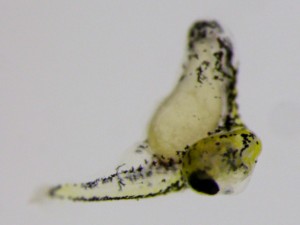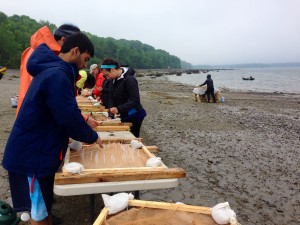Blog post from Katie Paulson ’15
One thing we have been working on in lab is breeding the zebrafish to produce embryos for our research.
This involves, among other things, fishing them out of small tanks (not easy at first since they move quickly!) and putting two females and two males each into breeding tanks. Unfortunately, one of the troubles with using live animals for research is that they are unpredictable and not entirely controllable. A couple of times we have set the zebrafish up to breed and didn’t get any embryos!
Luckily, this Monday morning we got a nice batch, but we killed them accidentally when we tried to remove the chorions enzymatically (we have to remove the embryos from their chorions in order to lay them out for photographs and measurements). Using embryos collected Tuesday morning we were able to start collecting pictures of them for our control set, meaning that we did not dose any of them with any of the chemicals we have chosen to study. We spent a large part of last week compiling a chart that covers what we expect to see at each time point during normal development, and now we are working on our own collection of evidence to tell us what normal healthy zebrafish look like during each time point.
Our picture taking process takes time and practice. We collect photographs at 9am, 3pm, 9pm, and 3am. Sophie and I have been taking the 9:00s this week and Nabil and Roshni have been photographing at the 3:00s, then next week we’ll switch. We’ll all certainly have our share of tired days and cups of coffee. Each time we take pictures it takes anywhere between one and three hours to get photographs of the 45 embryos we need for our sample size. Luckily we have some good tunes to keep us happy during those late night work hours! We’ve made a Williams Lab playlist and titled it “Embrynotes.”
Another bit of entertainment for us this week was a little embryo we watched grow up as an example of development gone wrong. We’re not really sure what happened but it’s a mutant of some sort with one eye and its head growing out the side of its body.
We can’t wait to see what kinds of problems in development we see once we start exposing the fish to chemicals!
In addition to the work we’ve been doing with zebrafish, we have also been spending some time working with Jane Disney’s lab (http://www.mdibl.org/community_lab.php) on their projects involving green crabs and eelgrass. Last Tuesday this meant gearing up in wet suits and taking a boat out to Stave Island to wade in the water there and collect eelgrass. We also joined the Disney lab and a group of high school volunteers to tie the eelgrass onto grids at Hadley Point on Wednesday. It was nice to be outside doing field research after spending a week reading through literature inside!
Res life at the lab has been going well too. On Wednesday in the co-op Don made tacos with guacamole and mango/pineapple salsa – my favorite! Last Sunday a large group of us undergraduate students went for another beautiful hike in Acadia National Park. This place is truly stunning and it seems like there are endless possibilities of trails, peaks, and views to hit. I’m so happy I get to spend the rest of my summer in this beautiful place!

